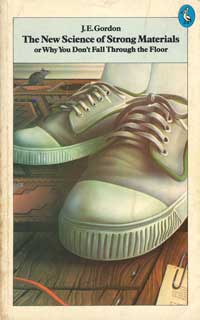
Why You Don't Fall Through the Floor
J. E. Gordon
London, 1976.
Dated though it may be, in some ways, this remains a very readable and useful introduction to materials science, and provides insights into many of the issues raised by Buckminster Fuller in his theories about the use of industrial materials for architecture.
We can see, for example, that Fuller was not alone in emphasizing the crucial importance of steel:
"The cheapening and improvement of iron and steel during the eighteenth and nineteenth centuries was the most important event of its kind in history - or perhaps just the most important event in history." (p.46)
Interesting divergences appear on the subject of tension and compression, however. Fuller extolled the virtues of steel in tension as opposed to stones under compression in buildings, but Gordon adds an important point:
"For a great many centuries engineers and architects avoided using materials in tension as much as they could. This was not so much because they had no materials strong in tension - wood, for example, is excellent - but rather because of the difficulty of making reliable strong joints to withstand tension." (p.46)
Gordon trained in naval architecture and worked on aircraft during WW2, and draws on a vast experience to illustrate his account. The writing is enjoyably breezy, with the odd bout of Harris Tweed harumphing dotted about:
"Professor Biggs [who?] tells me that if one looks at housing from the total energy point of view - that is to say, if one considers the energy needed to make and to transport the materials, as well as the energy consumed during the life of the building in heating it - then the traditional English thatched and half-timbered cottage is probably better than anything else. Rather predictably, this is just what one is not allowed to build under the present regulations." (p.264)
Gordon expands on these and other themes in Structures.
© Paul Taylor 2000